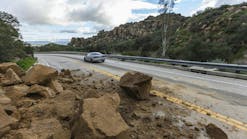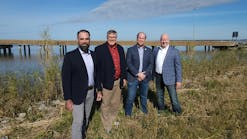The COVID-19 pandemic has impacted the world and our lives in numerous ways—too many to list. A recent study from the University of Bonn using GNSS, however, has found a somewhat unusual consequence of the pandemic. When countries around the world went into lockdown earlier this year in response to the COVID-19 pandemic, many industries shut down, which caused a variety of negative social and economic consequences. Geodesy, a branch of earth science that studies Earth's shape and gravity field, however, has actually benefitted from the drastic reduction in human activity.
GNSS makes it possible to continuously measure shallow changes in the Earth's surface and the study shows that the quality of these measurements may have improved significantly during the pandemic, at least at some stations. More precise geodetic data are important for assessing flood risks and for improving earthquake early warning systems. The study, published in Geophysical Research Letters, examined the precise location of a GNSS antenna in Boston, MA.
GNSS receivers can determine their positions to an accuracy of a few millimeters by using the US GPS satellites and the Russian GLONASS satellites. It's also possible to measure the distance between the GNSS antenna and the surface of the ground; researchers, for instance, can measure the wave-like propagation of an earthquake and the rise and fall of coastal areas.
"This has recently allowed our research group to measure elevation changes in the uppermost of soil layers without installing additional equipment," explains Dr. Makan Karegar from the Institute of Geodesy and Geoinformation at the University of Bonn.
Part of the satellite signal is reflected by nearby objects and the environment, reaching the GNSS antenna with a delay. When superimposed on the signal directly received by the antenna, it forms patterns called "interference" and can be used to calculate the distance between the antenna and the ground surface, which can change over time. Knowing precisely how the distance changes is important for calculating flood risk in coastal areas.
This method works well if the surrounding ground is flat, like the surface of a mirror. "But many GNSS receivers are mounted on buildings in cities or in industrial zones," explains Prof. Dr. Jürgen Kusche. "And they are often surrounded by large parking lots—as is the case with the antenna we investigated in Boston."
The researchers were able to show that parked cars significantly reduce the quality of elevation data by scattering the satellite signal and causing it to be reflected several times before reaching the antenna. This reduces both the intensity of the signal and the amount of information that can be extracted from it—the data is noisy. Additionally, because the pattern of parked cars changes every day, it's not easy to correct the data.
"Before the pandemic, measurements of antenna height had an average accuracy of about 4 centimeters due to the higher level of noise," says Karegar. "During the lockdown, however, there were almost no vehicles parked in the vicinity of the antenna; this improved the accuracy to about 2 centimeters." This is significant, as the more reliable the data, the smaller the elevation fluctuations that can be detected in upper soil layers.
In the past, the preference was to install GNSS stations in sparsely populated areas, but there are benefits to urban installations.
"Precise GNSS sensors are often installed in urban areas to support positioning services for engineering and surveying applications, and eventually for scientific applications such as deformation studies and natural hazards assessment," says Karegar. "Our study recommends that we should try to avoid installation of GNNS sensors next to parking lots."
Accurate knowledge of subsidence and even small changes to elevation changes are key to creating accurate flood maps and how changes could affect flooding coastal regions in particular.






